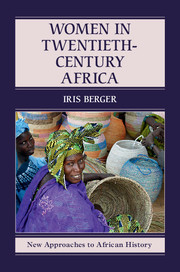To what extent is feminism a Western idea? Is feminism really relevant in Africa? How should traditional values and norms be balanced with the need for gender sensitivity? How have traditional religions interacted with the global religions of Christianity and Islam to develop African churches and Islamic groups? How did independence and the economic developments since then affect the position of women in society? This book attempts to answer all these questions. It thus throws much light on the position of women and girls in our society and how this needs to change further in the direction of equality, liberation and gender sensitivity.Africa provides some examples of the most horrific rape, violence and oppression suffered by women. But also of great hope in terms of the struggle by women supported by some men to build a new society where women and men can live together as mutually supportive equals. History provides many examples of women leading struggles, nations and being awarded Noble Peace Prizes; but also of untold women who have come to together to better their collective lives.
We saw the end of racial discrimination in South Africa and the former Rhodesia (now Zimbabwe) before the end of the twentieth century. But most African societies, even those paying lip-service to ‘gender sensitivity’, in practice accept the worst forms of discrimination against women. Women tend to work longer hours (including domestic labour), get paid less, have fewer legal rights and even less control over their own bodies than men.
Pre-colonial societies were greatly variable “ranging from centralised kingdoms with strong rulers and clear patterns of social hierarchy to smaller-scale communities based around extended families and clans” (page 3). In most of these societies men were politically and economically dominant and richer men could have more than one wife. But virtually everywhere women had a great deal of freedom and authority both within their families and in public life (especially after their childbearing years).
The colonial era led to a relative worsening of the position of women. Some of the worst aspects of ‘traditional society’ were strengthened and the rulers came from what were, at the time, highly patriarchal European societies. This setback was largely reversed during the nationalist and independence movements that were influenced by, and in turn fed in to, the global feminist movements at the time most African governments gained independence.
However, these achievements were threatened by the economic collapse across Africa that in turn created the conditions for multiple civil wars during and after the 1980s. As a result, the struggle for equality between the sexes has a long way to go.
The book introduces many African women writers and organisers coming to terms with their cultural heritage and the fast changing political and economic conditions. From Nigeria these include, for example, the author Buchi Emecheta, Alimotu Pelewura a Muslim leader of the Lagos Market Women’s Association who joined the major general strike in 1945, Bene Madunagu who played an important role in forming Women in Nigeria in 1983 and Dr Eka Esu-Williams who initiated programs to assist Nigerian sex workers in the 1990s.
Funmilayo Ransome-Kuti was one of the first western educated women in the South West and helped to organise market women. As a feminist and socialist and one of the leaders of the nationalist movement she said “As women we still feel we are inferior to men, we inherited this from our mothers, whose spirits had been subdued by slavery and we have to join hands to shake of this feeling” (page 74). She was also a fierce supporter of her son Fela Kuti, the Afrobeat musician.
The experience of Binta a Hausa woman born in the late colonial period just out-side Kaduna mirrored the life of many. She divorced her first husband who she married aged 12 or 13 and who gained custody of her two children. She went on to marry a railway worker and had three more children. During the economic turmoil of the 1980s she gained important income as a market woman, but also gained some formal education in Hausa, Arabic and English.
The widespread growth of western education for girls was one of the major achievements of the immediate post-colonial period. But this tailed off during the 1980s, largely due to the introduction of school fees. The military government of Nigeria in the mid-1980s sent soldiers to the markets to beat female traders supported by an ideology that saw a women’s proper place being in the home.
In contrast, Thomas Sankara in Burkina Faso saw women’s emancipation as one of his priorities, promoting literacy, health care and market co-operatives. The new family code he passed sought to curb bridewealth, provide a minimum age for marriage and divorce by mutual consent. It also sought to reduce polygyny, female genital mutilation (FGM), widows having to marry their late husbands’ brothers and giving them the right to inherit land and other wealth from their husbands. This government also appointed women to ministerial positions and senior public sector posts.
By the mid-1980s modern contraceptive use was widespread, at least in urban areas. The HIV-AIDS outbreak led at least to more widespread use of condoms. However, too few African women are yet to control their own fertility and so their own bodies – this must be a basic human right! All women should have access to modern contraceptives with abortion freely available as a safety net.
In Nigeria, there were many women’s organisations, but until 1980 they accepted that men should be the “bosses and heads of the family” (page 168). This changed with the formation of Women In Nigeria in 1983 led by the socialist and feminist Bene Madunagu. WIN managed to change the debate over gender subordination in Nigeria. It also broadened its membership base to include “the poorer women and men whom it sought to represent” (page 168).
Unfortunately, female genital mutilation (FGM) is still widespread (but declining) in Nigeria where UNICEF estimates that 20 million girls and women have suffered from this horror – around 10% of the global total. In Ebonyi State and Osun State three quarters of women may have suffered one form of FGM or another. The over-whelming majority of Nigerian women now believe that such practices should be discontinued. Although more wealthier and better educated urban women have suffered from FGM. Legal restrictions have been introduced since 2015 at the Federal level and in at least some of the states.
by Tina Ndi









